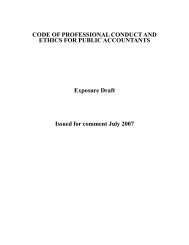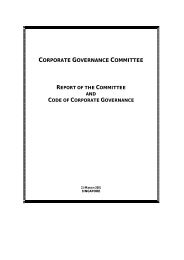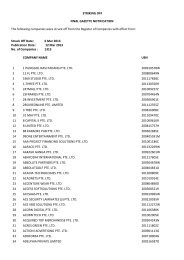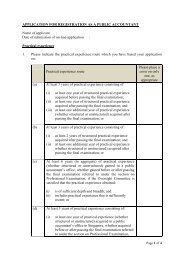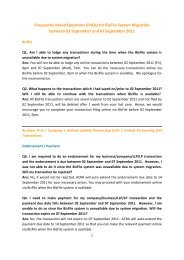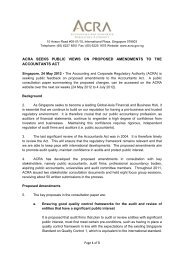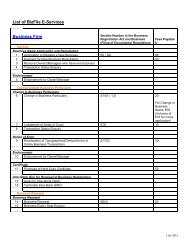Section 10: Closing a Local Company - ACRA
Section 10: Closing a Local Company - ACRA
Section 10: Closing a Local Company - ACRA
Create successful ePaper yourself
Turn your PDF publications into a flip-book with our unique Google optimized e-Paper software.
<strong>Section</strong> <strong>10</strong> – Contents
90 <strong>Closing</strong> a <strong>Local</strong> <strong>Company</strong><br />
<strong>Section</strong> <strong>10</strong> <strong>Closing</strong> a <strong>Local</strong> <strong>Company</strong><br />
As a director, it is important to have<br />
basic knowledge of the necessary<br />
procedures to close a company.<br />
Depending on the circumstances,<br />
there are two ways to close a local<br />
company. One is to apply to strike off<br />
the company with <strong>ACRA</strong> if it is able<br />
to meet the necessary requirements,<br />
while the other is to wind up the<br />
company with professional assistance.<br />
<strong>10</strong>.1 Striking off a company<br />
Directors can only apply for a company’s name to be struck off if it has<br />
ceased operations and meets certain criteria.<br />
<strong>10</strong>.1.1 What are the criteria which must be satisfied for striking off?<br />
ALL of the following criteria must be satisfied before a company can apply<br />
to be struck off.<br />
The company<br />
• has stopped trading or has not conducted business since the date<br />
of incorporation<br />
• has no outstanding tax liabilities with Inland Revenue Authority of<br />
Singapore (IRAS)<br />
• is not indebted or owing money to any government departments<br />
• has no outstanding charges in the company’s charge register<br />
• must not be involved in or be threatened with any court proceedings<br />
within or outside Singapore<br />
• Has no current or contingent assets and liabilities
<strong>Closing</strong> a <strong>Local</strong> <strong>Company</strong><br />
91<br />
In addition, the majority of the shareholders must give written agreement<br />
for the company to be struck off. When applying for striking off, the<br />
company’s accounts must be drawn up till the date of cessation of<br />
operations as indicated in the application.<br />
If the company does not fully meet these requirements, the directors may<br />
alternatively choose to close the company by winding up which will be<br />
discussed in further detail later in the chapter.<br />
What if the company has been dormant since incorporation?<br />
If the company has been dormant since incorporation, the<br />
director(s) or the <strong>Company</strong> Secretary has to submit a covering<br />
letter stating that the company had<br />
a. No business transactions since incorporation<br />
b. Not opened a bank account or that the bank account has<br />
been closed<br />
c. Not previously held an Annual General Meeting (AGM) or<br />
the first AGM to be held within 18 months from the date of<br />
incorporation is not due<br />
<strong>10</strong>.1.2 How to apply for striking off?<br />
An application for a company to be struck off must be submitted online via<br />
Bizfile. The application may be approved if <strong>ACRA</strong> reasonably believes that<br />
the company is not carrying on business anymore and that the company<br />
is able to satisfy the criteria for striking off. Thus, it is important to ensure<br />
that the company meets the necessary requirements before making the<br />
application. Note that in the event any false information is provided when<br />
the application is made, the applicant may be charged for the offence<br />
of making a false statement. The penalty upon conviction is a fine not<br />
exceeding S$50,000 or imprisonment not exceeding 2 years or both 1 .<br />
Refer to page 154 for guidance in lodging application for striking off.<br />
1<br />
<strong>Section</strong> 401(2) of the Companies Act
92 <strong>Closing</strong> a <strong>Local</strong> <strong>Company</strong><br />
<strong>10</strong>.1.3 Who can apply for striking off?<br />
As an officer of the company, the director or the <strong>Company</strong> Secretary can<br />
apply for the company to be struck off via Bizfile using their SingPass.<br />
Alternatively, the company may choose to engage the services of a<br />
professional firm or service bureau to submit the application.<br />
<strong>ACRA</strong> will process the application within 5 working days. Once the<br />
application is approved, <strong>ACRA</strong> will send a striking off notice to the<br />
company’s registered office address, its officers (directors and <strong>Company</strong><br />
Secretary) at their residential address and to IRAS.<br />
<strong>10</strong>.1.4 Objections to Striking off<br />
Parties who are against the company being struck off can lodge their<br />
objection online via Bizfile. If an objection is received, the company will<br />
be notified of the objection and the company’s application for striking<br />
off will be temporarily suspended. The company will be given 2 months<br />
to resolve the outstanding issues with the objector. The application for<br />
striking off will only be allowed to proceed when the objector lifts the<br />
objection. If the issue is not resolved after 2 months, the application will<br />
be rejected. The company will continue to remain on the Register and will<br />
have to submit a fresh application to be struck off.<br />
Creditors and IRAS are some parties who may be against<br />
the striking off of a company. Creditors may object if the<br />
company has outstanding debts whereas IRAS may object<br />
if the company has outstanding tax liabilities.
<strong>Closing</strong> a <strong>Local</strong> <strong>Company</strong><br />
93<br />
If no objection is received after a 1-month period, <strong>ACRA</strong> will publish<br />
the name of the company in the Government Gazette. This is known as<br />
the First Gazette Notification. If no objection is received after a further<br />
3-month period from the First Gazette Notification, the name of the<br />
company will be successfully struck off the register. The entire process<br />
from submitting the application to successfully being struck off from the<br />
Register will usually take 5 months.<br />
<strong>10</strong>.2 Winding up a company<br />
Other than striking off, a company can be closed down through winding<br />
up, which is commonly known as liquidation. In winding up, a liquidator is<br />
appointed to sell the company’s assets for cash. These proceeds will then<br />
be distributed among the company’s creditors and whatever remaining<br />
assets will be returned to the members.<br />
There are two main categories of winding up:<br />
1. Voluntary winding up:<br />
a. Members’ voluntary winding up<br />
b. Creditors’ voluntary winding up<br />
2. Compulsory winding up:<br />
a. On grounds of insolvency; or<br />
b. Other grounds<br />
It is advisable for you to seek professional advice if your company requires<br />
further information or assistance on the subject.<br />
<strong>10</strong>.2.1 Voluntary Winding Up<br />
A company can be wound up voluntarily upon a resolution being passed<br />
by the company. It will either be by way of members’ or creditors’<br />
voluntary winding up. Both types of voluntary winding up need to be<br />
initiated by a special resolution passed by the company’s members at a<br />
general meeting.
94 <strong>Closing</strong> a <strong>Local</strong> <strong>Company</strong><br />
<strong>10</strong>.2.1.1 Members’ Voluntary Winding up<br />
A members’ voluntary winding up involves the liquidation of a company<br />
that is still solvent.<br />
The process is initiated when the company has stopped operating and a<br />
general meeting of members is held. Before the members’ meeting, the<br />
directors must declare that they believe the company will be able to pay<br />
its debts in full within 12 months after the commencement of the winding<br />
up 2 . The members will then have to pass a special resolution 3 in a general<br />
meeting for the company to be wound up voluntarily 4 . A liquidator must<br />
be appointed to wind up the affairs of the company 5 and file the required<br />
notifications. Once a liquidator is appointed, the directors will no longer<br />
have any authority to run the company 6 .<br />
When does voluntarily winding up commence?<br />
Voluntary winding up is taken to have commenced when the<br />
resolution for voluntary winding up is passed 7 .<br />
<strong>10</strong>.2.1.2 Creditors’ Voluntary Winding up<br />
The company may opt for a “creditors’ voluntary winding up” if its<br />
directors believe that the company cannot continue to operate due to<br />
its liabilities. Hence, unlike a members’ voluntary winding up, a creditors’<br />
winding up is the liquidation of an insolvent company.<br />
If the company started out with a members’ voluntary<br />
winding up and it is later found that the company is not<br />
able to pay its debts in full within 12 months, then the<br />
winding up will be converted into a creditors’ voluntary<br />
winding up.<br />
2<br />
<strong>Section</strong> 293 of the Companies Act<br />
3<br />
More than 75% of those entitled to vote, vote in favour of the resolution.<br />
4<br />
<strong>Section</strong> 290 of the Companies Act<br />
5<br />
<strong>Section</strong> 294(1) of the Companies Act<br />
6<br />
<strong>Section</strong> 294(2) of the Companies Act<br />
7<br />
<strong>Section</strong> 255(1) of the Companies Act
<strong>Closing</strong> a <strong>Local</strong> <strong>Company</strong><br />
95<br />
Where a company is insolvent, the members must at a general meeting<br />
pass a special resolution for it to be wound up voluntarily. A meeting<br />
of creditors will then be called and held 8 . At least 7 days’ notice of<br />
the meeting must be given to the creditors by post, and the company<br />
must also advertise a notice of the meeting in a newspaper circulating<br />
in Singapore. At the meeting, the directors will report on the affairs of<br />
the company and propose a winding up of the company. If all members<br />
are agreeable, a special resolution will be passed and a liquidator will be<br />
appointed to wind up its affairs and file the required notifications.<br />
<strong>10</strong>.2.2 Compulsory Winding up<br />
A company may be wound up by an Order of the Court under certain<br />
circumstances, one of which is for reason of insolvency.<br />
When is a company deemed to be insolvent under compulsory<br />
winding up?<br />
A company is deemed to be insolvent when the company is<br />
unable to pay all its debts when they become due and payable 9 .<br />
The Court may then appoint a liquidator to wind up the company.<br />
When no liquidator is appointed by the Court, the Official<br />
Receiver will assume the role of liquidator of the company.<br />
The company may also be wound up through court order for other<br />
reasons <strong>10</strong> . Some common grounds where companies are wound up by<br />
court order are:<br />
• The company has not started business within 1 year from its incorporation<br />
or has suspended its business for the duration of one year or longer.<br />
• Directors have acted in their self interest rather than the company’s<br />
interest, or in a way which is unfair to the company or members.<br />
8<br />
<strong>Section</strong> 296 of the Companies Act<br />
9<br />
<strong>Section</strong> 254(1)(e) of the Companies Act<br />
<strong>10</strong><br />
<strong>Section</strong> 254(1) of the Companies Act
96 <strong>Closing</strong> a <strong>Local</strong> <strong>Company</strong><br />
<strong>10</strong>.3 Receivership<br />
A company may be placed under receivership when it is in financial<br />
difficulties and is unable to repay its creditors. Receivership is a method<br />
for creditors to get their money back from the company. This is because<br />
the receiver appointed by the creditor will try to recover payment for that<br />
creditor by controlling some or all of the company’s assets.<br />
The powers of the receiver will be stated in the terms of the debenture.<br />
Debenture…<br />
A debenture is a document that states the terms of a loan and<br />
may also contain the creditors’ rights to appoint a receiver if the<br />
company fails to repay. However, do note that not all creditors<br />
have the right to appoint a receiver. If the creditor is allowed to<br />
appoint a receiver, the debenture will further state the powers of<br />
the receiver. Some receivers can control the entire property and<br />
business of the company, while some receivers can only control<br />
certain assets of the company.<br />
Receiver…<br />
A receiver is a person appointed to take control of some or all of<br />
a company’s assets. A receiver may be appointed by a court or a<br />
secured creditor. The receiver will work for his appointer and try<br />
to recover the amount owed by the company to them.<br />
When the company is under receivership, the directors will lose their<br />
power and control over the company’s assets. However, the directors are<br />
still responsible for carrying out their duties under the Act such as holding<br />
the Annual General Meeting and filing the returns on time.<br />
Unlike in liquidation, the company is still an existing entity and may<br />
continue with its business at the end of a receivership.
<strong>Closing</strong> a <strong>Local</strong> <strong>Company</strong><br />
97<br />
<strong>10</strong>.4 Judicial Management<br />
A company may be placed under judicial management when it is facing<br />
financial difficulties and is/will be unable to pay its debts. If there is still<br />
a possibility of rehabilitating the company, the court may on application<br />
place the company in Judicial Management instead of winding up the<br />
company 11 . Judicial management is a way of placing the company in a<br />
temporary safe zone where the company is protected from any claims<br />
from its creditors. A judicial manager will come up with a proposal to<br />
rehabilitate the company. During the period when the company is<br />
protected from its creditors, the creditors will consider whether to accept<br />
the plan proposed by the judicial manager. If the proposal is accepted,<br />
the judicial manager will take control of the company’s property and<br />
business to try to rehabilitate the company and bring the company back<br />
to financial health.<br />
Under judicial management, the powers of directors are<br />
transferred to the judicial manager. Hence, if your company<br />
is under judicial management, you and your co-directors<br />
will lose your powers to manage the company.



